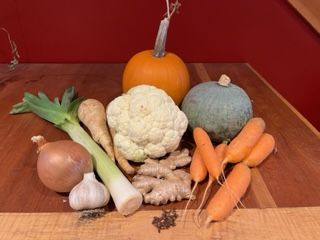As winter months approach and the temperatures drop, it becomes essential to pay close attention to your nutrition. The cold, icy conditions and longer hours of darkness can pose challenges to exercising and accessing food, healthcare, and social opportunities. These factors can magnify health issues, making it even more important to focus on a balanced and nourishing diet tailored to the season. In this article, we offer a few nutrition tips to support you in the winter, highlighting some nutrients to pay attention to and ways to eat with the season to support overall health and well-being.
Let’s start with vitamin D, often referred to as the “sunshine vitamin.” Vitamin D is a fat-soluble vitamin that helps your body absorb calcium, build strong bones and a healthy immune system, and supports mental health. Your body makes vitamin D when your skin is exposed to ultraviolet B (UVB) rays from the sun. As you age, your body’s ability to make vitamin D from sunlight decreases. In New England from November through February, there is negligible vitamin D-producing UVB light reaching the earth’s surface, limiting your body’s ability to make vitamin D. Therefore, getting your vitamin D from food and/or supplements is essential in the winter.
Winter vegetables are rich in vitamins, minerals, fiber, and antioxidants to support your overall health, and can be prepared in a variety of ways such as roasting, steaming, or made into soups to create hearty, nourishing, and warming meals.
The recommended daily allowance for vitamin D is 15 micrograms or 600 IUs for people aged 1-70 years, and 20 micrograms or 800 IUs for people older than 70 years. Good food sources of vitamin D include cod liver oil, trout, salmon, mushrooms exposed to UVB light, fortified milk, and other fortified foods. Sardines, tuna, beef liver, and eggs also have vitamin D but in smaller amounts. It is difficult for most people to get adequate vitamin D through food alone. For example, 1 cup of milk only provides about 15% of your daily needs and 1 egg provides about 6%. You should consult with your healthcare provider if you think you might benefit from vitamin D supplementation.
Another important nutrient to consider in the winter is vitamin C, a water-soluble vitamin that is crucial for supporting the immune system and maintaining healthy skin. Vitamin C stimulates the activity of white blood cells and antibodies in our bodies for a healthy immune response, which can help fight colds and lessen your symptoms. Additionally, Vitamin C is a powerful antioxidant, able to reduce damage to your cells from oxidation. This is important because it may lower risk of heart disease, certain cancers, and other diseases. Vitamin C is also needed to make collagen, a protein important for wound healing and skin integrity. Foods high in vitamin C include citrus fruits like lemons and oranges, as well as strawberries and kiwis. Vegetables such as peppers, broccoli, brussel sprouts, and leafy greens also have high amounts. Vitamin C can be destroyed by heat and light, so eating foods raw and at peak ripeness, and using quick heating methods like stir-frying or blanching, can help preserve the vitamin.
When it comes to healthy fats, omega-3 fatty acids are key players. Omega-3 fatty acids are polyunsaturated, essential fats that your body cannot produce on its own and must get through food. Omega-3 fatty acids have anti-inflammatory properties, which can help manage joint pain and support heart health. Omega-3 fatty acids are also important for supporting mental health and cognitive function; studies have shown that omega-3s can lower risk of depression and dementia. There are different types of omega-3 fatty acids including EPA and DHA which can be found in a variety of seafood like salmon, shrimp, and fish oils, and ALA which come from plant sources like flaxseeds, chia seeds, and walnuts, as well as soybean and canola oils. Your body can convert ALA to EPA and DHA (which is better absorbed and utilized) in small amounts. Incorporating foods with omega-3 fatty acids into your winter meals is an important way to support your overall well-being.
Another way to embrace winter is to eat what’s in season; this can allow you to connect with nature’s rhythms and be nourished by foods that are fresh and locally grown. Fall harvests of root vegetables, leafy greens, brussels sprouts, and winter squash often become sweeter after a touch of cold weather, bringing nutrient-dense deliciousness for enjoyment in the winter. Root vegetables like garlic, onions, potatoes, sweet potatoes, carrots, parsnips, turnips, beets, and celeriac, as well as winter squash, can store well through the winter in proper conditions. Winter vegetables are rich in vitamins, minerals, fiber, and antioxidants to support your overall health, and can be prepared in a variety of ways such as roasting, steaming, or made into soups to create hearty, nourishing, and warming meals.
Adding herbs and spices to winter cooking is another way to add warmth and flavor to your diet. Spices such as ginger, cinnamon, cloves, nutmeg, and black pepper that are commonly used in winter holiday recipes are considered warming as they can promote blood circulation and help with digestion. Many herbs and spices also have antimicrobial and anti-inflammatory properties to help fend off illness in the winter. So, get creative and experiment with herbs and spices in soups, stews, teas, and baked goods to broaden your palate and boost your health.
Lastly, staying properly hydrated is essential year-round, but is easy to overlook in winter when you may not feel as thirsty. Dehydration can cause dry skin and constipation, and lead to urinary tract infections and other serious complications. Fortunately, there are many ways to stay hydrated besides drinking water. Fruits and vegetables, which we may forget about, are excellent options as they have high water content while providing essential nutrients. Herbal teas and homemade soups are also great options in winter to provide hydration, warmth, and comfort.
Recipe: Warming Winter Vegetables
Ingredients
- 8 cups mixed winter vegetables, chopped (examples: carrots, cauliflower, parsnips, winter squash, potatoes, brussels sprouts)
- 1 large onion, diced
- 2 tablespoons olive oil
- 4 cloves garlic, diced
- 2″ piece of fresh ginger, cut into thin matchsticks
- 4 whole cloves
- ¼ tsp ground cinnamon
- ¼ tsp ground turmeric
- ¼ tsp black pepper
- ½ tsp salt
- 1 can coconut milk
- ½ cup water
- 1 fresh lime, juiced
Instructions
- Saute onion in oil in a pot for about 3 minutes, stirring frequently.
- Add garlic, ginger, cloves, cinnamon, turmeric, black pepper, and salt; cook for 1 minute.
- Add vegetables, and pour in ⅔ of the coconut milk and ½ cup water.
- Stir, cover, and simmer for about 20 minutes, until vegetables are soft.
- Stir in remaining coconut milk, cover and cook for 2 more minutes.
- Mix in lime juice just before serving.






